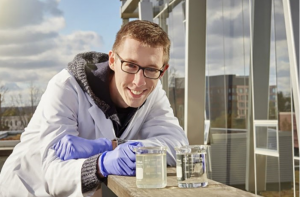Last year around 2.3 million barrels of oil were pulled each day from tar sands in Alberta, Canada, the third largest oil reserve in the world. This mining process is
hugely water-intensive, and though much of it is recycled, it still results in massive pools of polluted waste-water which are difficult to treat and pose a threat to the
environment. Canadian researchers have developed a new approach to removing the contaminants using sunlight and nanoparticles, an approach they say will prove
much more effective and cheaper than existing methods.
Extracting bitumen, a form of crude oil, from sands involves adding a whole lot of warm water and then agitating the mixture. The Government of Alberta says that
80 to 95 percent of the water is then recycled. But whatever water is leftover is then pumped into tailing ponds, dam-like structures designed to contain the harmful
contaminants that cover around 77 sq km (30 sq mi) of the province. The concerns are that it can leak into the nearby water systems, increase the risk of soil erosion
and also poison wildlife.
The key culprit behind the wastewater’s toxicity is the presence of napthenic acids, which still linger even after decades have passed. University of Calgary scientists
are looking into their own method of biotreatment that uses algae and bacteria to degrade the napthenic acids, in an effort to improve on the expensive and inefficient
process of using chlorine or membrane filtering.
But their compatriots at the University of Waterloo now claim to have identified a more energy-efficient and practical way forward. It is based on photocatalysis, a
chemical reaction whereby titanium dioxide molecules are activated by UV light to produce free radicals capable of destroying bacteria, fungi and other organisms. In
the past we have seen photocatalysis used in the development of air purifying clothes and self-cleaning windows and walls.
In tests conducted on a sample of oil sand wastewater, the University of Waterloo scientists found that the process broke down the toxic compounds, completely freeing
the water of napthenic acids within hours. Promisingly, the technique is powered entirely by sunlight, and the robust nano particles can be retrieved and used over and over.
“With about a billion tonnes of water stored in ponds in Alberta, removing naphthenic acids is one of the largest environmental challenges in Canada,” says Tim Leshuk,
a PhD candidate in chemical engineering at Waterloo and lead author of this paper. “Conventional treatments people have tried either haven’t worked, or if they have
worked, they’ve been far too impractical or expensive to solve the size of the problem. Waterloo’s technology is the first step of what looks like a very practical and green
treatment method.”
From here, the researchers will aim to establish that the resulting water is safe enough to be discharged from large sources, such as tailing ponds.
The research was published in the journal Chemosphere.







